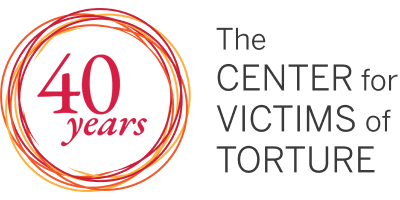Mohamed Jelani is a psychosocial counselor, CVT Ethiopia.
In the refugee camps here in northern Ethiopia, people come from different places and cultures. However, one thing many have in common is that they have survived torture and traumatic experiences. In order to help survivors begin to heal, it’s important to understand their culture and ensure that they get care through counseling and follow-up care afterward. At CVT, we want to make sure they continue to make progress in rebuilding their lives.
I grew up in Sudan, where my family is from. I then lived in Eritrea, where I served as a teacher for 14 years, followed by three years working as an electrician. Because of these residences, I know different cultures and I speak a number of languages. Also, my family was tortured and faced many very difficult circumstances. So I also know about trauma and surviving difficult experiences.
After I came to the camp in Ethiopia, I saw a notice of vacancy for a psychosocial counselor position with CVT. I was interested in working with CVT because of my background, but also because I am the father of children. I need to meet their needs and provide for my family. Also if a person is sitting idle in the refugee camp, it’s not good. It’s better to step up and get involved. Sitting idle is the worst thing. I applied for the job and passed both the interviews and the written exam. I was successful and got the job in 2013.
My role as a psychosocial counselor has many different components. Primarily, I work with CVT’s ten-week counseling cycles, which are held with groups of men, women and children who have survived torture and traumatic experiences. Also, CVT requires interpreters for work with many clients who speak a variety of languages, with the majority of interpretation in Tigrigna. Because I am fluent in Saho speech, I also am an interpreter for many clients.
I am also active in two types of sessions we hold with the refugee community: sensitization sessions for community awareness and psychoeducation sessions. Through these sessions, we explain to the community the kinds of symptoms people experience after they have lived through traumatic situations. We also tell them about the work of CVT and the way rehabilitative care helps people overcome those symptoms and problems. We want people to know that their symptoms are normal for what they have experienced, that they can get help, and to understand what kinds of services are available at CVT.
We also take care to define torture so they understand it clearly. Many people are new to the concept of trauma and unfamiliar with what kinds of symptoms result from difficult and violent situations. The idea of psychosocial care is not always acceptable to the community at first. So we tell them if they have symptoms to contact us – that we are always available for them to access care. We also suggest that if they observe problems in others, they tell their zone leaders in the camp. We work closely with the zone leaders, so we know they will contact CVT when someone reaches out for help. We want to ensure the community knows how to watch for signs of trauma, understands them and refers each other for support.
For healing, it is very important to involve the community. We need to start with sensitization and education so the community understands the symptoms and people will come to CVT for help. With an initial understanding about symptoms and care, they come to group counseling and begin to improve. After the counseling cycle, we do follow-up visits months later. In these visits, I really see where they have come to lead more normal lives. This is very important to me.
Clients come to us with many kinds of stories, different types of traumatic experiences. I recently worked with clients who were victims of an attack in the Sinai desert in Egypt. They were victims of traffickers and had been badly impacted. They came to CVT and participated in group counseling. Now most are working, earning a living and leading normal lives. Some of these Sinai victims now have a chance to go to other countries, possibly to Canada. Now they are in a good situation.
The part I enjoy the most about my work is during the healing process when people begin to get improvements from the group counseling. I consider this very holy work. They replace a bad situation with a good situation. It’s very rewarding. CVT’s work is a great thing. It’s very important – we are an empowering resource and we provide continuing training. And this also gives me a concern. CVT is limited to refugees in the Mai Ayni and Adi Harush camps, but there are also Eritreans and survivors in other camps. In my opinion CVT should expand to them.
I want the world to know about CVT and this kind of healing.
CVT’s work with Eritrean refugees in Ethiopia is funded by a grant from the U.S. State Department’s Bureau of Population, Refugees, and Migration.
